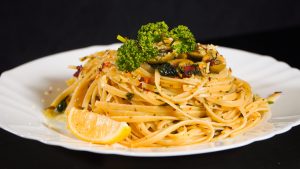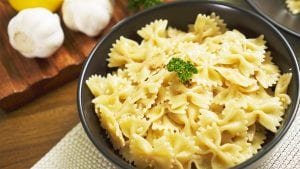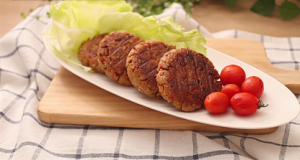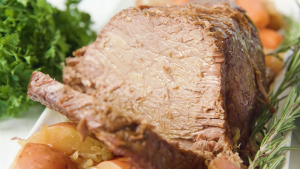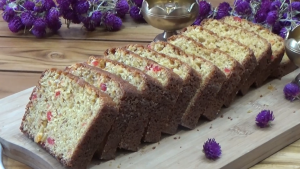Spaghetti Aglio e Olio is a traditional Italian pasta dish from Naples. It is a minimalist's dream, as it requires very few ingredients, and takes little time to prepare. However, its simplicity doesn't detract from its rich flavor, which is a combination of garlic, olive oil, and a kick of red pepper flakes.
The ingredients for this dish are quite straightforward and easy to find in any supermarket. However, you might want to pay special attention to the type of olive oil and Parmigiano-Reggiano cheese you choose. A good quality extra virgin olive oil will give this dish its characteristic flavor. As for the cheese, make sure to get authentic Parmigiano-Reggiano, which has a unique nutty and savory flavor.
Ingredients for Classic Spaghetti Aglio e Olio
Spaghetti: The base of this dish, it absorbs the flavors of the garlic and oil.
Garlic: Thinly sliced, it's slowly toasted to bring out its nutty flavor.
Olive oil: It forms the flavorful sauce that coats the spaghetti.
Red pepper flakes: They add a spicy kick to the dish.
Salt and black pepper: These seasonings enhance the other flavors.
Italian parsley: It adds a fresh element to balance out the richness of the oil and cheese.
Parmigiano-Reggiano cheese: Finely grated, it melts into the pasta and forms a salty, savory topping.
One reader, Dannie Matthews says:





This classic spaghetti aglio e olio recipe is a game-changer! The simplicity of the ingredients combined with the burst of flavors is truly remarkable. The garlic-infused olive oil and the kick of red pepper flakes create a perfect harmony. It's a go-to dish for a quick, satisfying meal.
Techniques Required for Classic Spaghetti Aglio e Olio
How to cook spaghetti: Boil the spaghetti in lightly salted water until it is cooked through but still firm to the bite, about 12 minutes. Drain and transfer to a pasta bowl.
How to toast garlic: Combine garlic and olive oil in a cold skillet. Cook over medium heat to slowly toast the garlic for about 10 minutes. Reduce the heat to medium-low when the olive oil begins to bubble. Cook and stir until the garlic is golden brown, about another 5 minutes. Remove from heat.
How to season the pasta: Stir red pepper flakes, black pepper, and salt into the cooked pasta. Pour in the olive oil and garlic, and sprinkle on Italian parsley and half of the Parmigiano-Reggiano cheese. Stir until combined.
How to serve the pasta: Serve the pasta topped with the remaining Parmigiano-Reggiano cheese.
How To Make Spaghetti Aglio e Olio
Whip up a batch of this authentic Italian Spaghetti aglio e olio! It’s made with just 5 ingredients, and easy to cook up for a quick dinner meal.
Serves:
Ingredients
- 1lbspaghetti
- 2tspgarlicchopped
- ¼cupparsleychopped
- ¼tspred pepper flakescrushed
- ¼cupolive oil
- ¼cupbuttermelted
Instructions
-
In a large pot with boiling salted water, the cook spaghetti pasta until al dente. Drain.
-
In a large skillet over low heat, sauté the garlic, parsley, and red pepper flakes with olive oil.
-
Cook for 10 to 15 minutes, until the garlic turns golden in color.
-
Toss pasta with garlic mixture and butter.
-
Serve warm, and enjoy!
Nutrition
- Calories: 322.68kcal
- Fat: 13.38g
- Saturated Fat: 4.74g
- Trans Fat: 0.23g
- Monounsaturated Fat: 6.52g
- Polyunsaturated Fat: 1.25g
- Carbohydrates: 42.71g
- Fiber: 1.90g
- Sugar: 1.55g
- Protein: 7.56g
- Cholesterol: 15.25mg
- Sodium: 5.51mg
- Calcium: 17.54mg
- Potassium: 141.85mg
- Iron: 0.91mg
- Vitamin A: 56.73µg
- Vitamin C: 2.72mg
Key Technique Tip for Perfect Spaghetti Aglio e Olio
When toasting the garlic in the olive oil, it's crucial to keep the heat at medium to medium-low. This slow cooking process allows the garlic to infuse the oil with its flavor without burning. If the garlic burns, it can become bitter and ruin the overall taste of your spaghetti aglio e olio. Also, remember to stir the garlic occasionally for even browning.
Time-Saving Tips for Preparing Spaghetti Aglio e Olio
Prep ahead: Chop and slice the garlic and parsley in advance to save time during the cooking process.
Use a garlic press: Instead of thinly slicing the garlic, use a garlic press to quickly crush the garlic cloves for the recipe.
Boil water in advance: Boil the water for the pasta while preparing the other ingredients to expedite the cooking process.
Multi-task: While the garlic is toasting, use that time to grate the cheese and chop the parsley for efficiency.
Quality ingredients: Use high-quality extra virgin olive oil and freshly grated parmigiano-reggiano cheese for enhanced flavor.
Taste as you go: Adjust the seasoning and spice levels as you cook to ensure the dish is perfectly seasoned.
Substitute Ingredients For Spaghetti Aglio e Olio Recipe
spaghetti - Substitute with linguine: Linguine is a great substitute for spaghetti in this recipe, as it has a similar texture and shape, and will hold the sauce well.
garlic - Substitute with shallots: Shallots can be used as a substitute for garlic, providing a milder and slightly sweeter flavor to the dish.
olive oil - Substitute with avocado oil: Avocado oil can be used as a substitute for olive oil, offering a mild flavor and high smoke point, making it suitable for sautéing the garlic.
red pepper flakes - Substitute with chili powder: Chili powder can be used as a substitute for red pepper flakes, providing a similar heat level and adding a smoky flavor to the dish.
Italian parsley - Substitute with cilantro: Cilantro can be used as a substitute for Italian parsley, adding a fresh and citrusy flavor to the dish.
parmigiano-reggiano cheese - Substitute with pecorino romano cheese: Pecorino Romano cheese can be used as a substitute for parmigiano-reggiano, offering a slightly sharper and saltier flavor to the dish.
Presenting Your Spaghetti Aglio e Olio
Elevate the plating: When presenting the classic spaghetti aglio e olio, focus on creating an elegant and refined plating. Use a wide-rimmed pasta bowl to showcase the beautiful strands of spaghetti, and ensure that the dish is presented with precision and attention to detail.
Garnish with fresh herbs: Add a touch of vibrancy to the dish by garnishing with freshly chopped Italian parsley. The bright green color will provide a visually appealing contrast against the golden tones of the pasta and olive oil, enhancing the overall presentation.
Incorporate texture: Consider adding a subtle textural element to the presentation, such as a delicate sprinkle of finely grated parmigiano-reggiano cheese. This not only adds depth of flavor but also contributes to the visual appeal of the dish.
Emphasize simplicity: Embrace the simplicity of the dish by focusing on clean lines and minimalistic plating. Allow the natural colors and textures of the ingredients to take center stage, creating a visually striking yet understated presentation.
Highlight the aroma: As you present the dish, aim to showcase the enticing aroma of the garlic-infused olive oil. This can be achieved by serving the pasta immediately after tossing it with the fragrant oil, allowing the aroma to captivate the senses of the diners.
Essential Tools for Making Spaghetti Aglio e Olio
- Large pot: A large pot is essential for boiling the spaghetti.
- Skillet: A skillet is used to toast the garlic and combine it with the olive oil.
- Pasta bowl: The pasta bowl is used to hold the cooked spaghetti.
- Grater: A grater is used to finely grate the parmigiano-reggiano cheese.
- Colander: A colander is used to drain the cooked spaghetti.
- Spatula: A spatula is used for stirring the spaghetti and combining it with the garlic and oil.
- Measuring cup: A measuring cup is used to measure the olive oil.
- Knife: A knife is used to thinly slice the garlic.
- Cutting board: A cutting board is used as a surface for slicing the garlic.
- Tongs: Tongs are used to toss the spaghetti with the garlic and oil.
- Grater: A grater is used to finely grate the parmigiano-reggiano cheese.
Storing and Freezing Spaghetti Aglio e Olio
Here are the detailed storing and freezing guidelines for classic spaghetti aglio e olio:
- To store leftovers, allow the pasta to cool completely to room temperature. Transfer to an airtight container and refrigerate for up to 5 days.
- When ready to reheat, place the desired portion in a skillet over medium-low heat. Add a splash of olive oil or water to help loosen the sauce and prevent the pasta from sticking. Stir gently until heated through.
- For longer storage, you can freeze the spaghetti aglio e olio. Place the cooled pasta in a freezer-safe container or resealable plastic bag. Remove as much air as possible to prevent freezer burn. Label the container with the date and freeze for up to 2 months.
- To reheat frozen spaghetti aglio e olio, transfer the container from the freezer to the refrigerator and let it thaw overnight. Once thawed, follow the reheating instructions above.
- Note: The texture of the pasta may change slightly after freezing and thawing, as it can become softer. To minimize this, undercook the spaghetti slightly before storing, so it retains some firmness when reheated.
- If you plan to freeze the dish, consider leaving out the parsley and Parmigiano-Reggiano cheese. Instead, add these fresh ingredients when reheating the pasta for the best flavor and texture.
How to Reheat Leftover Spaghetti Aglio e Olio
The best way to reheat leftover spaghetti aglio e olio is to use a skillet or a sauté pan. Heat a tablespoon of olive oil in the pan over medium heat. Once the oil is hot, add the leftover pasta and toss it gently to coat it evenly with the oil. Cook for 3-4 minutes, stirring occasionally, until the pasta is heated through and slightly crispy on the edges.
Another method is to use a microwave. Place the leftover spaghetti in a microwave-safe dish and add a splash of water or olive oil to prevent the pasta from drying out. Cover the dish with a microwave-safe lid or plastic wrap, leaving a small vent for steam to escape. Microwave on high for 1-2 minutes, stirring halfway through, until the pasta is heated through.
If you prefer a more hands-off approach, you can reheat the spaghetti aglio e olio in the oven. Preheat the oven to 350°F (175°C). Place the leftover pasta in an oven-safe dish and add a splash of olive oil or a knob of butter. Cover the dish with foil and bake for 10-15 minutes, or until the pasta is heated through. Remove the foil for the last 2-3 minutes of baking to allow the top to crisp up slightly.
Regardless of the reheating method you choose, be sure to taste the spaghetti and adjust the seasoning as needed. You may want to add a pinch of red pepper flakes, a sprinkle of grated Parmigiano-Reggiano cheese, or a squeeze of fresh lemon juice to brighten up the flavors.
If the leftover spaghetti aglio e olio seems a bit dry, you can revive it by adding a small amount of reserved pasta water or chicken broth while reheating. This will help to loosen the sauce and make the pasta more creamy and delicious.
Random Fact About Spaghetti Aglio e Olio
Spaghetti aglio e olio is a traditional Italian pasta dish that originated in Naples. It is a simple and classic recipe that highlights the flavors of garlic, olive oil, and parsley. This dish is often considered a pantry staple as it requires minimal ingredients and can be whipped up quickly. Despite its simplicity, it is a beloved dish in Italian cuisine and is enjoyed by many around the world.
Is Making Spaghetti Aglio e Olio at Home Cost-Effective?
The cost-effectiveness of this spaghetti aglio e olio recipe largely depends on the quality of ingredients used. While olive oil and parmigiano-reggiano cheese can be expensive, the simplicity of the dish balances the cost. The recipe's versatility and ability to use pantry staples make it a budget-friendly option. Rating: 8/10. Approximate cost for a household of 4: $10-$15, depending on ingredient quality and availability.
Is Spaghetti Aglio e Olio Healthy or Unhealthy?
The classic spaghetti aglio e olio recipe, while delicious, may not be the healthiest option due to its high calorie and fat content. The dish relies heavily on olive oil, which is a healthy fat but can add up quickly in terms of calories. Additionally, the recipe calls for a generous amount of Parmigiano-Reggiano cheese, which is high in saturated fat and sodium. The refined carbohydrates from the spaghetti can also cause blood sugar spikes, especially if consumed in large portions.
To make this dish healthier, consider the following suggestions:
- Reduce the amount of olive oil used in the recipe, or opt for a lighter olive oil spray to cut down on calories and fat
- Use whole wheat spaghetti or zucchini noodles to increase the fiber content and reduce the impact on blood sugar levels
- Decrease the amount of Parmigiano-Reggiano cheese used, or replace it with a lower-fat alternative like nutritional yeast or a sprinkle of low-fat feta cheese
- Add more vegetables to the dish, such as roasted cherry tomatoes, sautéed spinach, or grilled zucchini, to increase the nutrient density and fiber content
- Use fresh herbs like basil or oregano to add flavor without increasing the calorie or sodium content
Editor's Thoughts on This Classic Italian Dish
This classic spaghetti aglio e olio recipe is a timeless dish that celebrates the simplicity of Italian cuisine. The combination of garlic-infused olive oil, a hint of red pepper flakes, and the freshness of Italian parsley creates a harmonious flavor profile. The use of parmigiano-reggiano cheese adds a rich and savory element to the dish. The recipe's straightforward preparation allows the flavors to shine, making it a delightful and satisfying meal. Whether served as a quick weeknight dinner or as part of a special gathering, this dish is sure to impress with its rustic charm and comforting taste.
Enhance Your Spaghetti Aglio e Olio Recipe with These Unique Side Dishes:
Alternative Recipes Similar to Spaghetti Aglio e Olio
Perfect Appetizers and Desserts for a Spaghetti Aglio e Olio Meal
Why trust this Spaghetti Aglio e Olio Recipe:
This classic spaghetti aglio e olio recipe is a timeless favorite, crafted with care and expertise. The simplicity of the ingredients, such as garlic, olive oil, and parmigiano-reggiano cheese, ensures an authentic and flavorful experience. The method of slowly toasting the garlic in olive oil infuses the dish with a rich, aromatic essence. The addition of red pepper flakes provides a subtle kick, while the Italian parsley lends a fresh, herbaceous note. This recipe guarantees a delightful and satisfying dining experience, earning the trust of all who savor its exquisite flavors.
Was this page helpful?
Have your own special recipe to share? Submit Your Recipe Today!




